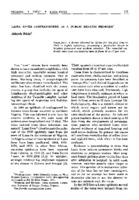Lassa fever (arenaviruses) as a public health problem
| dc.contributor.author | Fabiyi, A | es_ES |
| dc.date.accessioned | 2016 | |
| dc.date.available | 2016 | |
| dc.date.issued | 1976 | es_ES |
| dc.identifier.uri | https://iris.paho.org/handle/10665.2/27639 | |
| dc.description.abstract | Two «new» virus infections, Marburg and Lassa fever, now constitute diseases of public health importance in several countries of Africa, especially West Africa. Lassa fever has an insidious onset, is initially difficult to diagnose, has «nonspecific» clinical symptoms which have been confused with yellow fever and typhoid, shows evidence of persistent infection, is tremendously contagious, has a high mortality rate, and in particular exhibits unusual nosocomial propensity. It has also been shown to be the cause of premature births and spontaneous abortions in pregnant women. The virus is transmitted by the respiratory route and by direct contact with contaminated materials. Persistent complement-fixing antibodies have been demonstrated in patients recovered from the disease. The causative agent, a member of the arenavirus group, is known to be enzootic in rodents, especially Mastomys natalensis (Au) | en_US |
| dc.relation.ispartofseries | Bulletin of the Pan American Health Organization (PAHO);10(4),1976 | en_US |
| dc.subject | FIEBRE LASSA | es_ES |
| dc.subject | Lassa Virus | es_ES |
| dc.subject | Lassa Virus | es_ES |
| dc.subject | Nigeria | es_ES |
| dc.title | Lassa fever (arenaviruses) as a public health problem | es_ES |
| dc.type | Journal articles | en_US |
| dc.rights.holder | Pan American Health Organization | en_US |
Files in this item
This item appears in the following Collection(s)
-
Pan American Journal of Public Health
Revista Panamericana de Salud Pública




